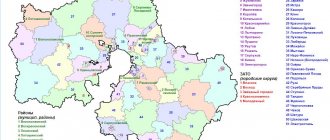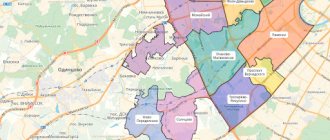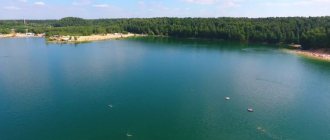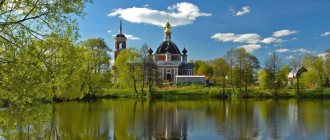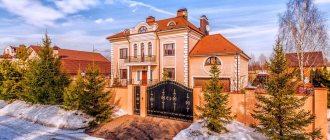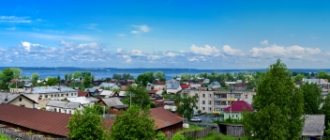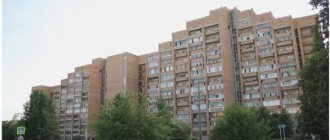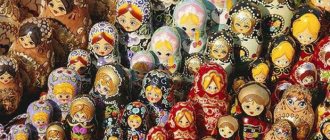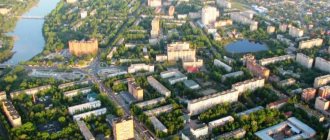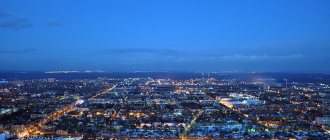Nature
The region is located predominantly on the plain. In the western part it is hilly and elevated, and in the eastern part it is flat and lowland.
The climate is moderate continental, with well-defined seasons, including transitional ones. Summers are warm and winters are moderately cold. In the east of the region, winters are colder and summers are hotter. The average annual precipitation is 713 mm.
The river network belongs to the Volga River basin.
The vegetation is represented by forests and meadows. In the north, coniferous spruce forests predominate, in the south – coniferous-broad-leaved, deciduous forests.
Administrative division
This division is required to ensure management functions and is regulated by a special law of the Moscow Region. To optimize local self-government, a municipal structure is used. The territories of municipalities of the Moscow region have local urban, and not regional (unlike districts) subordination. Their typical size is small.
The region is also divided into larger administrative-territorial units - districts of the Moscow region. Each district is divided into rural and urban settlements. There are also urban districts and cities of regional subordination, as well as closed administrative-territorial entities.
The sizes of districts in the Moscow region are extremely diverse. In general, the system of administrative-territorial division in the region is quite complex and differs in this from that in other regions of the Russian Federation, for example, in the Krasnodar Territory or in the Rostov Region, which are divided into approximately equal in size districts, governed by the heads of administrations of the corresponding districts.
The total number of districts of the Moscow region is 51. The picture of the administrative-territorial division of the Moscow region is further complicated by the presence of a separate entity - the city of Moscow. Its borders are quite chaotic; There are separate island territories, also subordinate to Moscow. The Moscow urban district cuts the region almost in half, leaving only a wide northeastern bridge. Such a chaotic division can hardly be considered appropriate. Rather, it is the result of spontaneous transformations and insufficiently thought-out decisions.
Thus, the territory of Moscow and the Moscow region has a complex, confusing and not entirely rational zoning. And this differs from many other regions of the Russian Federation.
Prospects
According to experts, residential real estate in the city of Moskovsky will become even more in demand: the reason for this is the proximity to the capital, the massive commissioning of new housing and the fact that prices on the market for new buildings in Moskovsky are not yet so high.
What can be concluded? The city of Moscow has a certain investment attractiveness and favorable prospects, and is an interesting object for those who want to invest available funds in real estate in order to subsequently make a profit from resale or rental.
Apartments in new buildings in Moskovsky are more affordable than their analogues, for example, in Podolsk, because the main segment of housing being built is economy and economy+: these are standard panel houses of well-proven series (for example, P-44T, which flooded Moscow at the very end of 1990- x - early 2000s) without security, parking and with not very high ceilings, partial possibility of redevelopment, but allowing the owner to buy a larger number of square meters for himself and his future family compared to, say, a monolithic house of an individual project.
Did you find this article helpful? Please share it on social networks: Don't forget to bookmark the Nedvio website. We talk about construction, renovation, and country real estate in an interesting, useful and understandable way.
Protected areas of the Moscow region
Some parts of the region are under protection. Thus, in the Serpukhov region there is the Prioksko-Terrasny Biosphere Reserve. The bison and communities of the northernmost steppe formations of the European part of the country are protected there. Another important protected site is the Zavidovo National Park, part of which already belongs to the Tver region. Other protected objects are: the Botanical Garden of Medicinal Plants, a natural monument called “Lake Kiev”, and the Yablokov Arboretum.
In total, there are more than 200 specially protected natural areas in the region. To improve the quality of nature conservation, a regional Red Book has been published since 1998.
The spread of coronavirus in Russia by region today
| Region | Infected | Died | Recovered |
| Moscow | 2 124 92711 557 | 38 15470 | 1 915 6332 307 |
| Moscow region | 675 1542 795 | 12 91839 | 613 2991 313 |
| Saint Petersburg | 897 8514 753 | 29 24860 | 830 7232 646 |
| Nizhny Novgorod Region | 238 918661 | 10 28916 | 224 16655 |
| Sverdlovsk region | 208 071695 | 9 82216 | 183 14755 |
| Rostov region | 201 849599 | 9 9228 | 181 883259 |
| Krasnoyarsk region | 179 110426 | 9 20025 | 163 590354 |
| Dagestan | 68 384188 | 3 2971 | 62 10582 |
| Khanty-Mansiysk Autonomous Okrug - Ugra | 99 486447 | 2 1155 | 93 51198 |
| Tula region | 79 432253 | 4 48113 | 70 021160 |
| Voronezh region | 199 670489 | 7 17811 | 178 6431 554 |
| Kaluga region | 67 716149 | 1 2691 | 63 01262 |
| Bryansk region | 99 754178 | 3 11111 | 95 258172 |
| Chelyabinsk region | 151 321313 | 6 3987 | 142 31841 |
| Krasnodar region | 128 291757 | 9 9779 | 105 82975 |
| Saratov region | 137 249276 | 5 2579 | 128 012260 |
| Volgograd region | 133 547322 | 5 84814 | 123 233147 |
| Irkutsk region | 163 054445 | 7 24618 | 149 395249 |
| Novosibirsk region | 99 838240 | 4 49213 | 71 150357 |
| Bashkortostan | 126 361281 | 4 6118 | 117 474277 |
| Ryazan Oblast | 63 435148 | 2 75815 | 58 25212 |
| Ulyanovsk region | 122 701174 | 3 99814 | 116 136121 |
| Chuvashia | 47 721116 | 4 1607 | 41 36467 |
| Arhangelsk region | 127 190305 | 1 5551 | 117 287302 |
| Kursk region | 83 876175 | 2 1346 | 79 480174 |
| Kabardino-Balkaria | 43 65680 | 1 5373 | 39 64581 |
| Murmansk region | 94 107160 | 2 8686 | 78 002250 |
| Yaroslavl region | 89 622231 | 2 0364 | 81 39749 |
| Tambov Region | 64 507179 | 1 8548 | 58 97897 |
| Samara Region | 205 608527 | 6 57711 | 180 0621 398 |
| Stavropol region | 132 286680 | 6 33412 | 114 637932 |
| Penza region | 105 340196 | 4 8099 | 95 395203 |
| Smolensk region | 87 473211 | 2 4997 | 80 358151 |
| Tatarstan | 44 745112 | 1 5405 | 38 009103 |
| Oryol Region | 73 215225 | 1 5922 | 67 74969 |
| Yamalo-Nenets Autonomous Okrug | 63 373131 | 9741 | 59 790211 |
| Ivanovo region | 70 405129 | 2 6618 | 62 82239 |
| Leningrad region | 106 883340 | 3 1034 | 98 369401 |
| Vladimir region | 85 051266 | 3 0294 | 77 669342 |
| Belgorod region | 84 068182 | 1 8615 | 76 485180 |
| North Ossetia | 32 36475 | 1 0505 | 30 06886 |
| Yakutia | 80 027761 | 1 8383 | 73 9060 |
| Primorsky Krai | 107 864336 | 1 6527 | 91 267399 |
| Khabarovsk region | 130 183272 | 1 3083 | 122 804459 |
| Lipetsk region | 86 946233 | 2 9556 | 80 523120 |
| Tyva | 31 99269 | 3320 | 30 94625 |
| Orenburg region | 110 181232 | 3 5574 | 99 782126 |
| Astrakhan region | 84 158238 | 2 5788 | 79 56967 |
| Perm region | 167 657540 | 7 6918 | 155 030373 |
| Tver region | 102 966281 | 2 4304 | 92 034268 |
| Mordovia | 41 62278 | 1 1013 | 37 449120 |
| Omsk region | 135 368376 | 3 39014 | 127 327314 |
| Kirov region | 82 647238 | 7973 | 73 571348 |
| Ingushetia | 30 03782 | 4973 | 28 13464 |
| Komi Republic | 99 596201 | 2 732 | 89 262664 |
| Karachay-Cherkessia | 33 45679 | 9261 | 30 166111 |
| Mari El | 30 22781 | 9602 | 28 29811 |
| Tyumen region | 94 843364 | 3 6398 | 83 787118 |
| Buryatia | 78 948185 | 2 5516 | 73 967114 |
| Transbaikal region | 98 143125 | 1 9855 | 90 122409 |
| Novgorod region | 67 671201 | 8082 | 64 318175 |
| Kaliningrad region | 85 842301 | 1 36711 | 81 97149 |
| Pskov region | 73 298144 | 1 3698 | 69 326101 |
| Kamchatka Krai | 24 44565 | 5242 | 19 54274 |
| Tomsk region | 64 292142 | 6910 | 58 104487 |
| Chechnya | 32 244159 | 9792 | 30 06544 |
| Khakassia | 55 204112 | 2 0890 | 51 80420 |
| Adygea | 28 61382 | 7982 | 24 601186 |
| Vologda Region | 102 209192 | 3 1215 | 94 771245 |
| Kalmykia | 34 32731 | 7610 | 32 81217 |
| Kostroma region | 49 593109 | 1 1480 | 47 78742 |
| Amur region | 57 611168 | 6323 | 53 131554 |
| Kemerovo region | 90 118298 | 1 8177 | 82 680316 |
| Udmurtia | 80 876245 | 3 2903 | 72 074357 |
| Karelia | 93 135335 | 1 2724 | 89 228303 |
| Republic of Crimea | 129 015221 | 4 61610 | 120 415220 |
| Magadan Region | 13 95633 | 3560 | 13 31912 |
| Kurgan region | 52 36489 | 1 0362 | 49 977105 |
| Sakhalin region | 44 468140 | 6004 | 42 343173 |
| Altai region | 125 769356 | 7 07726 | 107 675238 |
| Altai Republic | 25 79828 | 5402 | 23 61432 |
| Jewish Autonomous Region | 12 01525 | 4392 | 10 9673 |
| Sevastopol | 54 341121 | 1 9213 | 51 25987 |
| Chukotka Autonomous Okrug | 3 0004 | 390 | 2 8303 |
| Nenets Autonomous Okrug | 3 58712 | 890 | 3 4203 |
Municipal districts of the Moscow region
In total, there are 36 municipal districts in the Moscow region:
— Volokolamsk with its center in the city of Volokolamsk (index 143600).
- Voskresensky with its center in the city of Voskresensk (index 140200).
— Dmitrovsky with its center in the city of Dmitrov (index 141800).
— Zaraisky with its center in the city of Zaraysk (index 140600).
— Yegoryevsky with its center in the city of Yegoryevsk (index 140300).
— Istra with its center in the city of Istra (index 143500).
— Klinsky with its center in the city of Klin (index 141600).
— Kashirsky with its center in the city of Kashira (index 142903).
- Krasnogorsk with its center in the city of Krasnogorsk (index 143404).
- Kolomensky with its center in the city of Kolomna (index 140407).
- Leninsky with its center in the city of Vidnoye, Leninsky district (index 142700).
— Lukhovitsky with its center in the city of Lukhovitsy (index 140501).
— Lotoshinsky with its center in the city of Lotoshino, Lotoshinsky district (index 143800).
— Lyubertsy with its center in the city of Lyubertsy (index 140000).
— Mytishchi with its center in the city of Mytishchi (index 141008).
— Mozhaisk with its center in the city of Mozhaisk (index 143200).
— Naro-Fominsk with its center in the city of Naro-Fominsk (index 143300).
— Ozersky with its center in the city of Ozyory (index 140560).
— Odintsovo with its center in the city of Odintsovo (index 143000).
— Noginsky with its center in the city of Noginsk (index 142400).
— Podolsky with its center in the city of Podolsk (index 142100).
— Orekhovo-Zuevo with its center in the city of Orekhovo-Zuevo (index 142600).
— Pavlovsky Posad with its center in the city of Pavlovsky Posad (index 142500).
— Pushkinsky with its center in the city of Pushkino (index 141207).
— Ramenskoye with its center in the city of Ramenskoye (index 140100).
— Sergiev Posad with its center in the city of Sergiev Posad (index 141300).
- Ruzsky with its center in the city of Ruza (index 143100).
— Solnechnogorsk with its center in the city of Solnechnogorsk (index 141500).
— Serpukhovsky with its center in the city of Serpukhov (index 142203).
— Serebryano-Prudsky with its center in the city of Serebryanye Prudy, Serebryano-Prudsky district (index 142970).
- Stupinsky with its center in the city of Stupino (index 142800).
- Taldomsky with its center in the city of Taldom (index 141900).
— Shatura with its center in the city of Shatura (index 140700).
- Chekhovsky with its center in the city of Chekhov (index 142300).
— Shakhovsky with its center in the city of Shakhovskaya, Shakhovsky district (index 143700).
— Shchelkovsky with its center in the city of Shchelkovo (index 141100).
Improvement of the territory of the Moscow region
Territory improvement work is focused primarily on improving the condition of the courtyards of multi-storey buildings. For this purpose there is a special law “On improvement in the Moscow region”. When implementing it, methodological recommendations are used for organizing comprehensive landscaping of courtyard areas. This is the responsibility of the administration of the corresponding urban settlement.
The courtyard area is understood as land directly adjacent to apartment buildings and in common use. It may include a playground, parking, waste storage area, green space, lights, posters and other public facilities.
Comprehensive landscaping of the territory means bringing all the components of the territory described above to a standard state.
Activities to provide all these attributes and maintain them in proper condition are carried out annually. The greatest complaints are caused by the insufficient level of lighting in the areas and the dilapidation of children's playgrounds. There are also considerable problems with the condition of the road surface of internal and external roads.
Active work on comprehensive improvement was carried out in 2016. They included asphalting roads and paths, overhauling playgrounds, installing additional play elements, repairing fences, and installing information stands.
Property Features
Real estate in Moskovsky is in demand primarily because the city is located in the closest distance zone from the capital. In recent years, there has been massive housing construction, which means there is plenty to choose from.
Infill development is not enough; it is much more convenient to develop entire blocks and microdistricts, offering a full package of services: apartments in new buildings, modern utilities, roads and landscaping of the local area, infrastructure.
In terms of the volume of housing stock being commissioned, the city of Moskovsky is one of the three leaders in the region, and some projects in the city (for example, the Severny microdistrict with 64 residential buildings) are recognized as the most ambitious and largest of all those implemented to date.
What gives an additional bonus: the opportunity to invest in the construction of a new building in Moskovsky at an early stage (construction of the first floors or pouring a foundation pit) and thereby significantly benefit in price.
Ecological improvement
As part of the general improvement of the territory of the Moscow region, much attention should be paid to environmental measures. For example, such as clearing areas of garbage, cleaning water bodies, improving the condition of the road surface, landscaping residential complexes and public areas, repairing playgrounds, repairing dilapidated and dilapidated housing, and so on.
The obligatory nature of such events is dictated by considerations of quality of life and safety of the population. Thus, according to research by European scientists, the accumulation of plastic household waste in inappropriate places (landfills, ponds, etc.) and the abrasion of car tires by road surfaces leads to increasing pollution of all environments with microscopic particles and fibers of artificial polymers. And if we continue to turn a blind eye to this, then in the future there will be such a number of them that the health of a huge number of the planet’s inhabitants will be jeopardized.
Infrastructure
The city-forming enterprise is the Moskovsky Agricultural Plant. The agricultural complex's greenhouses, in which vegetables and flowers are grown, are spread over a vast territory. The agricultural complex is recognized as the largest in Russia and one of the largest in Europe.
In general, I must say, the residents of the city were very lucky with the city-forming enterprise. The agricultural complex produces organic vegetables and herbs, not coke or coal of any kind; in addition, it actively participates in the life of the city and region: it opens interesting sites, holds competitions for children, and promotes a healthy lifestyle and concern for the environment in a playful and educational way.
It should be noted that residents of Moskovskoye can not only consume greens in pots from the agricultural complex every day, but also admire the “greenery” on a larger scale - natural forests have been preserved around the city; in Moskovskoye itself, landscaping and landscaping of walking areas are actively underway.
Two small rivers are located within the city limits, and outside the city flows one of the largest rivers near Moscow, the Desna, which allows you to swim, fish, and engage in water sports.
